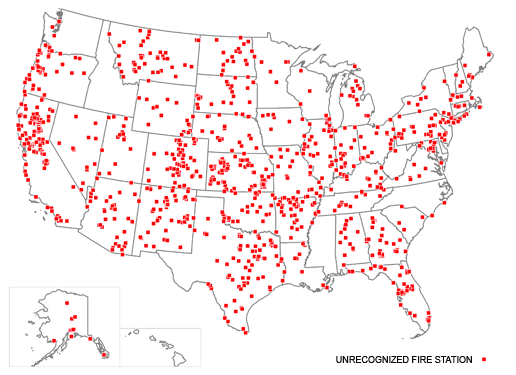In many communities across the country, the existence of a local fire station is a matter of significant pride and assurance that, if needed, emergency responders will arrive quickly to bring an incident to a safe and successful conclusion. However, as economic issues reverberate across the country, that assuredness may be called into question. The reasons for such concern are both simple and complex. They range from a lack of responders to more fundamental budgetary issues that may reduce or entirely eliminate the response capabilities of a particular station. In many cases, municipal leaders have few choices, and emotions run high when recommendations are made to furlough or lay off responders or temporarily “brown out” — or even close — a particular fire station.
The latest data from the Insurance Information Institute (I.I.I.) reiterates that fire remains the leading cause of property losses incurred in the homeowners marketplace. The National Fire Protection Association (NFPA) reports there were 515,000 structure fires in 2008, resulting in 2,900 civilian deaths, 14,960 civilian injuries, and $15.5 billion in property damage. In the last decade, fires have caused direct insured losses of more than $120 billion and countless billions in related costs. While other devastating perils such as hurricanes, earthquakes, and floods command deserved worldwide attention, building fires represent the daily drumbeat of losses across the country.
As key municipal decision makers in communities of all sizes come to grips with current economic realities, the fate of individual fire stations and related response times grabs headlines. In what the League of Cities calls a crisis, the worst may yet lay ahead, as the pace of personnel reductions and layoffs appears to be worsening. Results of the League’s May 2010 study on the subject shows that seven in ten city officials indicate they are responding to the economic crisis by making personnel cuts, including layoffs, hiring freezes, and furloughs.
And public safety spending is not spared. In addition to those municipalities cutting personnel, 68 percent are cutting capital projects. Postponement or outright cancellation of infrastructure investment is only pushing inevitable problems further down the road. For example, a 2008 report by the State and Local Government Law Institute estimated that $1.6 trillion will be needed to address growing needs.
As financial problems have evolved, the ramifications have spread from states to local jurisdictions. The chairman of the National Governors Association, Governor Jim Douglas of Vermont, said in early 2010 in the New York Times that the fiscal condition of most states was fairly poor and that the fiscal year starting July 1, 2010, would be the most difficult to date.
A full examination of the problem starts with the way most people interact with emergency services — usually alerting responders through a 911 call to a service that can range from a large, well-funded multicommunity agency to a small, overtaxed, understaffed, and underfunded municipal agency. Reducing the time from the report to the time help arrives is the primary objective of emergency services system planning.
National Fire Protection Association (NFPA) standards and those provided by the Commission on Fire Accreditation delineate best practices — all designed to shave seconds off the emergency call handling time. In addition, ISO (Insurance Services Office) analyzes information from its Fire Suppression Rating Schedule (FSRS) to assign Public Protection Classifications (PPC®) to almost 47,000 fire protection areas across the country — recognizing the efforts of communities to provide fire protection services in three major areas: emergency fire communications, water supply, and the fire department.
From those analyses, ISO has determined that more than 1,000 fire stations in the United States lack basic response capabilities for structure fires. On the surface that means the fire station may appear to have effective emergency response capabilities. But based on in-depth analysis, the station may not be able to mitigate structural fires within its area.
1,000+ Fire Stations Lacking Basic Response Capabilities in the U.S.

ISO has determined that more than 1,000 fire stations in the United States lack basic response capabilities for structure fires and are deemed insufficient for insurance recognition in the PPC program.
Through the application of the FSRS, ISO has determined that the operational effectiveness of a fire department and its deployed resources from fire stations is best realized through on-site analysis. ISO’s analysis of responder locations indicates that more than 20 percent of the U.S. population is served by a responding fire station that is not always the station nearest to the area it is designated to protect. This is sometimes the result of a lack of pre-emergency planning, which leverages automatic mutual aid and reduces travel time and distance to the scene. And in communities that have developed more recently, new construction can race ahead of the community’s ability to incorporate fire stations, leaving some areas poorly protected.
According to the NFPA, the nation’s fire departments respond to a structure fire on average once every minute. Therefore, an adequately staffed 911 center — equipped with the latest technology to help determine the location of the emergency and provide prompt dispatch — affords responders crucial minutes. The optimal scenario is a nearby fire department with adequate staff and equipment arriving promptly and having quick access to a water source with sufficient pressure and volume. If resources are too far away, the likelihood of damage rises. So does the potential for injury or death to building occupants.
A fire can intensify rapidly, and the risk of increased property damage and danger to people can increase dramatically. In an uncontrolled environment, rapid fire progression can lead to a dangerous condition known as flash over, during which contents of a room become fully engulfed in flames. In such a fire, temperatures can climb to nearly 1,000 degrees Fahrenheit — untenable heat for humans. The United States Fire Administration indicates that flashover can occur within nine minutes. Immediately deploying a fire station to thwart flash over is a key factor in a community’s fire protection plan. Prompt action minimizes the risk to occupants, property, and firefighters.
The fire hazards faced by today’s fire departments are much greater than those of our predecessors. The fire environment has changed drastically. Homes of yesterday had a fuel load of about 8,000 BTUs.
With today’s plastics load, 16,000 to18,000 BTUs can be expected. A National Fire Protection Agency Fire Analysis and Research report, Fire Service Fatalities in Structure Fires, states, “While the number of structure fires has dropped, the rate of firefighter deaths at structure fires has not.”
A recent study conducted by Underwriters Laboratories, Inc. (UL), in partnership with the Chicago Fire Department (CFD) and the International Association of Fire Chiefs (IAFC), stated that as more homes are constructed with lightweight materials, adequate personnel must be dispatched to ensure that basic fireground operations can be completed safely and quickly. The study revealed that engineered wood floors (lightweight construction) have the potential to collapse very quickly — six minutes from ignition in some cases. Today’s changing fire environment may require additional personnel and apparatus. Reduced staffing and longer response times due to station closings may have a greater effect on a fire chief’s risk-benefit analysis and strategic plan, leading to the potential for increased property damage.
But along with the significant aspect of response time, there’s much more to understand about how well fire departments perform their essential roles in saving lives and property. Staffing, training, incident management techniques, apparatus and equipment, and water supply, accessibility, and pressure must all be thoroughly analyzed from a risk mitigation perspective.
The Occupational Safety and Health Administration (OSHA) requires that at least two firefighters enter a structure for firefighting, with full self-contained breathing apparatus (SCBA) and direct visual or voice contact between each other and direct voice or radio contact with firefighters outside the structure. Another standard regulation — “two-in/two out” — requires that at least four firefighters must assemble at the scene of the fire before interior fire suppression activities take place.
The number of firefighters needed at the scene of a house fire was recently further quantified through scientific studies. A comprehensive study released in 2010 by the National Institute of Standards and Technology (NIST) concluded that four person firefighting crews were able to complete 22 essential firefighting and rescue tasks in a typical residential structure 30 percent faster than two-person crews and 25 percent faster than three-person crews. Many fire departments across the country cannot meet these staffing levels. Recruitment, retention, training, and funding problems lead to staffing shortages in all types of fire departments: career (paid), volunteer, and combination.
Responders must be adequately trained. And although many states and localities require standardized minimum training, problems still exist. One of the biggest obstacles surrounding recruitment is education and training requirements, according to the chiefs of volunteer and combination departments surveyed*. A white paper on volunteer firefighter training by the National Volunteer Fire Council reveals that a large number of volunteer departments are still operating with personnel who are not trained to a level consistent with national consensus standards.
How does a fire department cope with such obstacles? For many decades, the federal government refrained from supplying any significant financial support to local fire departments. That long-standing policy changed considerably in 2001, when Congress passed legislation that created the Assistance to Firefighters Grant Program (AFG).
The AFG was designed to enhance local fire department capabilities and firefighter safety within career, combination, and volunteer fire departments located in urban, suburban, and rural communities and tribal jurisdictions. Items eligible for grants include fire apparatus, personal protective equipment (PPE), firefighting equipment (such as large diameter hose, nozzles, thermal imaging cameras, and radios), firefighter training and wellness/fitness efforts, and fire prevention activities funded under the Fire Prevention and Safety Grants portion of the AFG.
In 2005, the federal government created another grant program, known as the Staffing for Adequate Fire and Emergency Response (SAFER) Program, to help fund additional career firefighters for local fire departments and to support volunteer fire departments with their recruitment and retention efforts. In 2009, as part of the American Recovery and Reinvestment Act (ARRA), Congress included $210 million for construction of new fire stations and certain modifications to existing fire stations to improve the capabilities of local fire departments in still another way. Since their inception, each of these various fire grant programs has enhanced local fire department capabilities and firefighter safety by supporting staffing, apparatus, equipment, training, and firefighter safety and fitness. To date, more than 50,000 grants have awarded more than $4 billion to local fire departments.
Each grant has effectively improved local fire protection capabilities where a justifiable need was previously not met — a tanker truck to a small rural fire department, an aerial ladder truck to a major metropolitan or suburban fire department, or simply expanded staffing. Best of all, when local fire department capabilities improve, property and casualty losses in those communities are likely to decrease — a direct benefit of those unique fire grant programs.
To overcome the shortfalls caused by economic issues, fire departments are entering into automatic-aid agreements with surrounding communities and merging and consolidating resources. These proactive shared-resource arrangements between fire departments focus on incident command, common training, and liability and other insurance coverages for responders, as well as any necessary overtime pay in advance of emergencies. Many fire service organizations, including the Mutual Aid Box Alarm System (MABAS), offer specialized expertise to administer such programs successfully.
Automatic aid is distinguished from mutual aid by time of dispatch. Automatic responders and primary responders are notified simultaneously to reduce any lag time between incident dispatch and arrival. Mutual aid is called on by an incident commander after the initial alarm, when the fire officer realizes that additional resources are needed. The gap between alarm notification and actual determination of conditions at the scene of an emergency that requires more help can sometimes be catastrophic in terms of lives and property lost. Automatic-aid agreements can often fill critical gaps in access to nearby apparatus, more responders, and specialized hauled water tenders. Such agreements can also reduce or eliminate response distance issues by reliance on a neighboring department that is closer to portions of a given jurisdiction.
In addition, the pace of consolidation and mergers of fire departments is increasing because of the many demands on emergency responders. In some cases, when adjacent departments are faced with the realities of a fiscal crisis — or are simply seeking a more efficient use of resources — their leaders conclude that combining efforts may make more sense than remaining independent. In Making the Pieces Fit, retired Fire Chief Jack W. Snook and Chief Jeff Johnson cite their own successful consolidation experience that led to the creation of the Tualatin Valley (Oregon) Fire and Rescue. Combining forces can lead to significant improvements in service levels with lower net costs to taxpayers.
Based on varying levels of financial stress on fire departments across the country, the effectiveness of local community fire protection may hang in the balance. We should all be aware of the unintended effects of the reduced capability of local responders deployed from individual fire stations. Changes to staffing, training, and adequacy and location of apparatus and equipment can affect the effectiveness of any fire department. Ultimately, the decisions made by local community leaders regarding individual fire stations can help save lives and protect property. Conversely, when capabilities are reduced below minimum criteria, such noble intentions are compromised, potentially leading to higher future losses.


